Alok Kumar Shukla1, Sheela Misra2, S. S. Mishra3, Subhash Kumar Yadav3
1Department of Statistics, D.A-V. College, Kanpur, U.P., India
2Department of Statistics, University of Lucknow, Lucknow, U.P., India
3Department of Mathematics and Statistics (A Centre of Excellence), Dr. RML Avadh University, Faizabad, U.P., India
Correspondence to: S. S. Mishra, Department of Mathematics and Statistics (A Centre of Excellence), Dr. RML Avadh University, Faizabad, U.P., India.
| Email: |  |
Copyright © 2015 Scientific & Academic Publishing. All Rights Reserved.
Abstract
This manuscript deals with the estimation of population variance using auxiliary variable through optimally searching developed class of modified ratio type estimators of population mean of the study variable. We have proposed a generalized class of estimators of population variance of the main variable under study. The proposed estimator is the generalization of the Subramani and Kumarapandiyan (2015) estimator with a characterizing scalar constant α which is to be obtained. The expressions for the bias and mean squared error of the proposed class of estimators have been obtained up to the first order of approximation. The optimum value of the characterizing scalar has been obtained by minimizing the mean squared error of the proposed class of estimators. The minimum value of the mean squared error has also been obtained for this optimum value of the characterizing scalar. At last an empirical study is also carried out through which we infer that the proposed estimator has minimum mean square error among the class of estimators of population variance as an optimal search condition.
Keywords:
Auxiliary variable, Parameter, Estimator, Bias, Mean Squared Error, Efficiency
Cite this paper: Alok Kumar Shukla, Sheela Misra, S. S. Mishra, Subhash Kumar Yadav, Optimal Search of Developed Class of Modified Ratio Estimators for Estimation of Population Variance, American Journal of Operational Research, Vol. 5 No. 4, 2015, pp. 82-95. doi: 10.5923/j.ajor.20150504.02.
1. Introduction
It has been seen in practice that the variance is one of the important measure of dispersion. For example we can see how the variation in production, variation in sales, variation in blood pressure etc affects the human beings. It plays a very important role in the field of Medical sciences, Biological sciences, Agriculture, Industry etc. So it is of great significance in above fields to estimate the variation. To estimate any parameter of the variable under study, the most appropriate estimator for the parameter is the corresponding statistic and in case of variance estimation, the most suitable estimator is the sample variance of the study variable. Being unbiased estimator of the population parameter, the sample variance should be preferred for the estimation but it has a big amount of variation among its values. Therefore we seek for such estimator which may be biased but it should have minimum mean squared error. Auxiliary variable which is generally highly positively or negatively correlated with the main variable under study fulfill the need in searching such estimator and its use lift up the efficiency of the estimator. When the main variable and the auxiliary variable are positively correlated, ratio type estimators are used for the estimation of population parameters under considerations. While the Product type estimators are used when main and auxiliary variables are negatively correlated to each other and the line of regression Y on X passes through origin and in other case regression estimators are used for the estimation of population parameters. In the present manuscript we have considered only positively correlated case using ratio type estimators of population variance. Let us consider that the finite population under investigation consist of N distinct and identifiable units and let  be a bivariate sample of size n taken from (X, Y) using a simple random sampling without replacement (SRSWOR) scheme. Let
be a bivariate sample of size n taken from (X, Y) using a simple random sampling without replacement (SRSWOR) scheme. Let  and
and  respectively be the population means of the auxiliary and the study variables, and let
respectively be the population means of the auxiliary and the study variables, and let  and
and  be the corresponding sample means.
be the corresponding sample means.  and
and  are the unbiased estimators of the population means
are the unbiased estimators of the population means  and
and  respectively. In the present manuscript we are searching for such an estimator of population variance which should have minimum mean squared error among the class of such estimators. The following notations early used by Subramani and Kumarapandiyan (2015) have been used in this manuscript as:
respectively. In the present manuscript we are searching for such an estimator of population variance which should have minimum mean squared error among the class of such estimators. The following notations early used by Subramani and Kumarapandiyan (2015) have been used in this manuscript as:  - Size of the population
- Size of the population - Size of the sample
- Size of the sample  - Study variable
- Study variable - Auxiliary variable
- Auxiliary variable - Median of the auxiliary variable
- Median of the auxiliary variable - Correlation coefficient between
- Correlation coefficient between  and
and 
 - Population means
- Population means - Sample means
- Sample means - Population variances
- Population variances - Sample variances
- Sample variances - Coefficient of variations
- Coefficient of variations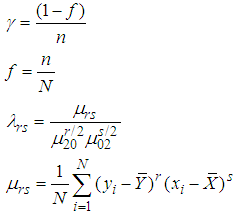
 , Skewness of the auxiliary variable
, Skewness of the auxiliary variable , Kurtosis of the auxiliary variable
, Kurtosis of the auxiliary variable - First quartile of the auxiliary variable
- First quartile of the auxiliary variable - Third quartile of the auxiliary variable
- Third quartile of the auxiliary variable - Inter quartile range of the auxiliary variable
- Inter quartile range of the auxiliary variable - Semi quartile range of the auxiliary variable
- Semi quartile range of the auxiliary variable - Semi quartile average of the auxiliary variable
- Semi quartile average of the auxiliary variable - ith Decile of the auxiliary variable
- ith Decile of the auxiliary variable - Bias of the estimator
- Bias of the estimator - Variance of the estimator
- Variance of the estimator - Mean squared error of the estimator
- Mean squared error of the estimator - Percentage relative efficiency of the estimator
- Percentage relative efficiency of the estimator  over
over  .
.
2. Review of Literature of Variance Estimators
The simplest and the most appropriate estimator of population variance is the sample variance given by: | (2.1) |
It is unbiased, and its variance up to the first degree of approximation is: | (2.2) |
Isaki (1983) proposed the following ratio estimator of population variance using auxiliary information as:  | (2.3) |
where
 The Bias and Mean Square Error (MSE) of the estimator in (2.3), up to the first order of approximation, are respectively given by
The Bias and Mean Square Error (MSE) of the estimator in (2.3), up to the first order of approximation, are respectively given by | (2.4) |
 | (2.5) |
Various authors in the literature have proposed so many estimators of population variance latest being Singh and Solanki (2013), Subramani and Kumarapandiyan (2012a, b, c, 2013), tailor and Shrama (2012), and Yadav and Kadilar (2013a, b), Yadav et al (2015a, b) utilizing different parameters of auxiliary variable. Table-1, early given by Subramani and Kumarpandiyan (2015), represents different estimators of population variance with their Bias and MSE.Table 1. Bias and MSE of Various Estimators
 |
| |
|
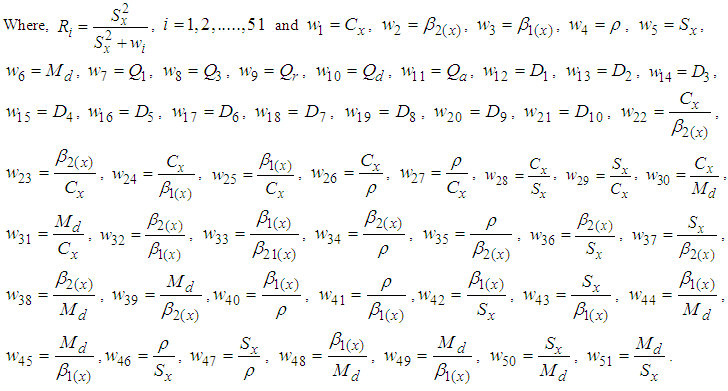 Thus the bias and MSE of 51 estimators mentioned above in the table may be written as,
Thus the bias and MSE of 51 estimators mentioned above in the table may be written as, | (2.6) |
Upadhyaya and Singh (2001) proposed the following estimator of population variance utilizing the population mean of the auxiliary variable as, | (2.7) |
The bias and the mean squared error of estimator up to the first order of approximation respectively are,  | (2.8) |
 | (2.9) |
Subramani and Kumarpandiyan (2015), using population mean of the auxiliary variable proposed the following modified estimators for population variance as,  | (2.10) |
The bias and the mean squared error of the estimator in (2.10), up to the first order of approximations respectively are,  | (2.11) |
 | (2.12) |
Where 
3. Proposed Class of Estimators
Motivated by Yadav et al (2015b), we proposed the following class of estimators using a characterizing scalar  as,
as, | (3.1) |
Where,  is a characterizing scalar obtained by minimizing the mean squared error of the proposed estimator
is a characterizing scalar obtained by minimizing the mean squared error of the proposed estimator  .To study the large sample properties of the proposed class of estimators, we define
.To study the large sample properties of the proposed class of estimators, we define and
and  such that
such that  and
and  ,
, 
 Using above approximations, the proposed estimator may be written as,
Using above approximations, the proposed estimator may be written as,
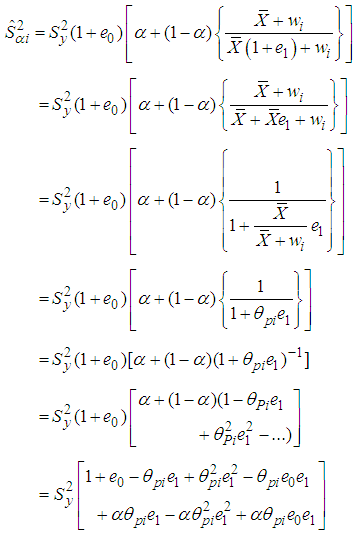 Through the order of approximations, retaining the terms up to the first order, we have
Through the order of approximations, retaining the terms up to the first order, we have  | (3.2) |
Subtracting  on both sides of (3.2), we have
on both sides of (3.2), we have | (3.3) |
Taking expectation on both the sides of equation (3.3), we get
 Putting the values of different expectations in above equation, we get the bias of the proposed class of estimators as,
Putting the values of different expectations in above equation, we get the bias of the proposed class of estimators as, | (3.4) |
Squaring on both sides of (3.3), simplifying and retaining the terms up to the first order of approximation, we have,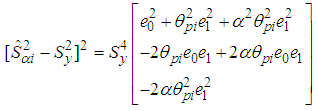 | (3.5) |
Taking expectations on both the sides of equation (3.5), we get the mean squared error of the proposed class of estimators up to the first order of approximation as, | (3.6) |
Putting the values of different expectations in above equations and simplifying, we have,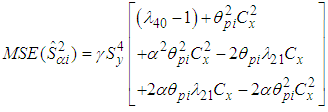 | (3.7) |
The optimum value of the characterizing scalar  is obtained by minimizing MSE in (3.7) using the method of maxima-minima as,
is obtained by minimizing MSE in (3.7) using the method of maxima-minima as,  | (3.8) |
Where  and
and  The minimum value of bias of the proposed class of estimators is obtained by putting optimum value of
The minimum value of bias of the proposed class of estimators is obtained by putting optimum value of  in (3.4) as,
in (3.4) as, | (3.9) |
Minimum value of the MSE of the proposed class of estimators is obtained by putting the optimum value of  in (3.7) and thus the minimum MSE is given as,
in (3.7) and thus the minimum MSE is given as, | (3.10) |
4. Efficiency of the Proposed Class of Estimators
From (2.2) and (3.10), we have: | (4.1) |
From (2.5) and (3.10), we have: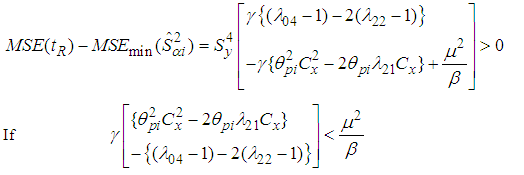 | (4.2) |
From (2.6) and (3.10), we have: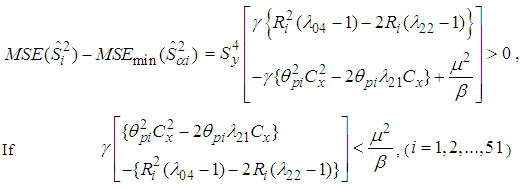 | (4.3) |
From (2.9) and (3.10), we have: | (4.4) |
From (2.12) and (3.10), we have: | (4.5) |
5. Numerical Study
To judge the performances of the proposed class of estimators along with the existing modified ratio type estimators of population variance given in this manuscript, we have considered two natural populations, the population-1 and Population-2. Both the populations have been taken from the book by Singh and Chaudhary (1986) at page 177. The population parameters of above populations are given below as:Population-1: Singh and Chaudhary (1986) Population-2: Singh and Chaudhary (1986)
Population-2: Singh and Chaudhary (1986) The following table represents the Bias and the Mean Squared Error (MSE) of proposed class of estimators with the existing modified ratio type estimators of population variance mentioned in the manuscript as,Note: Since the estimator
The following table represents the Bias and the Mean Squared Error (MSE) of proposed class of estimators with the existing modified ratio type estimators of population variance mentioned in the manuscript as,Note: Since the estimator  of the class of estimators proposed by Subramani and Kumarapandiyan (2015) has minimum MSE among its class and the rest estimators mentioned in above table except the proposed estimator. Therefore we have computed only
of the class of estimators proposed by Subramani and Kumarapandiyan (2015) has minimum MSE among its class and the rest estimators mentioned in above table except the proposed estimator. Therefore we have computed only  estimator of proposed class of estimators for both the populations corresponding to
estimator of proposed class of estimators for both the populations corresponding to  estimator.
estimator.Table 2. Bias and MSE of Various Estimators for Population-1
 |
| |
|
Table 3. Bias and MSE of Various Estimators for Population-2
 |
| |
|
6. Conclusions
In the present paper we develop a generalized improved class of estimators for population variance using population mean of the auxiliary variable by applying the scalar constant to Subramani and Kumarapandiyan (2015) estimator of population variance. The bias and the mean squared error of the proposed general class of estimators have been obtained up to the first order of approximation. The optimum value of the characterizing scalar has been obtained up to the first order of approximation and for this optimum value of the scalar, the minimum mean squared error of the proposed class of estimators have been obtained. From table-2 and table-3, we observe that the estimator  of the proposed class of estimators has the minimum mean squared error as compared to other mentioned existing estimators of population variance in this manuscript. Therefore it is strongly recommended that the proposed generalized class of estimators should be preferably used for the estimation of population variance using auxiliary variable under simple random sampling scheme.
of the proposed class of estimators has the minimum mean squared error as compared to other mentioned existing estimators of population variance in this manuscript. Therefore it is strongly recommended that the proposed generalized class of estimators should be preferably used for the estimation of population variance using auxiliary variable under simple random sampling scheme.
References
| [1] | ISAKI, C.T. 1983. Variance estimation using auxiliary information. Journal of the American Statistical Association, 78: 117-123. |
| [2] | SINGH, D. and CHAUDHARY, F.S. 1986. Theory and analysis of sample survey designs. New Age International Publisher. |
| [3] | SINGH, H.P. and SOLANKI, R.S. 2013. A new procedure for variance estimation in simple random sampling using auxiliary information. Statistical Papers, 54, 479-497 13-18. |
| [4] | SUBRAMANI, J. and KUMARAPANDIYAN, G. 2012a. Variance estimation using median of the auxiliary variable. International Journal of Probability and Statistics, Vol. 1(3), 36-40. |
| [5] | SUBRAMANI, J. and KUMARAPANDIYAN, G. 2012b. Variance estimation using quartiles and their functions of an auxiliary variable, International Journal of Statistics and Applications, 2012, Vol. 2(5), 67-42. |
| [6] | SUBRAMANI, J. and KUMARAPANDIYAN, G. 2012c. Estimation of variance using deciles of an auxiliary variable. Proceedings of International Conference on Frontiers of Statistics and Its Applications, Bonfring Publisher, 143-149. |
| [7] | SUBRAMANI, J. and KUMARAPANDIYAN, G. 2013. Estimation of variance using known coefficient of variation and median of an auxiliary variable. Journal of Modern Applied Statistical Methods, Vol. 12(1), 58-64. |
| [8] | SUBRAMANI, J. and KUMARAPANDIYAN, G. 2015. A Class of Modified Ratio Estimators for Estimation of Population Variance. JAMSI, 11, 1, 91-114. |
| [9] | TAILOR, R. and SHARMA, B. 2012. Modified estimators of population variance in presence of auxiliary information. Statistics in Transition-New series, 13(1), 37-46. |
| [10] | UPADHYAYA, L.N. and SINGH, H.P. 2001. Estimation of population standard deviation Using auxiliary information. American Journal of Mathematics and Management Sciences, 21(3-4), 345-358. |
| [11] | YADAV, S.K. and KADILAR, C. 2013a. A class of ratio-cum-dual to ratio estimator of Population variance. Journal of Reliability and Statistical Studies, 6(1), 29-34. |
| [12] | YADAV, S.K. and KADILAR, C. 2013b. Improved Exponential type ratio estimator of Population variance. Colombian Journal of Statistics, 36(1), 145-152. |
| [13] | YADAV, S.K., KADILAR, C., SHABBIR, J. and GUPTA, S. (2015a). Improved Family of Estimators of Population Variance in Simple Random Sampling, Journal of Statistical Theory and Practice, 9, 2, 219-226. |
| [14] | YADAV, S.K., MISHRA, S.S., SHUKLA, A.K. and TIWARI, V. (2015b). Improvement of Estimator for Population Variance using Correlation Coefficient and Quartiles of The Auxiliary Variable, Journal of Statistics Applications and Probability, 4, 2, 259-263. |

 be a bivariate sample of size n taken from (X, Y) using a simple random sampling without replacement (SRSWOR) scheme. Let
be a bivariate sample of size n taken from (X, Y) using a simple random sampling without replacement (SRSWOR) scheme. Let  and
and  respectively be the population means of the auxiliary and the study variables, and let
respectively be the population means of the auxiliary and the study variables, and let  and
and  be the corresponding sample means.
be the corresponding sample means.  and
and  are the unbiased estimators of the population means
are the unbiased estimators of the population means  and
and  respectively. In the present manuscript we are searching for such an estimator of population variance which should have minimum mean squared error among the class of such estimators. The following notations early used by Subramani and Kumarapandiyan (2015) have been used in this manuscript as:
respectively. In the present manuscript we are searching for such an estimator of population variance which should have minimum mean squared error among the class of such estimators. The following notations early used by Subramani and Kumarapandiyan (2015) have been used in this manuscript as:  - Size of the population
- Size of the population - Size of the sample
- Size of the sample  - Study variable
- Study variable - Auxiliary variable
- Auxiliary variable - Median of the auxiliary variable
- Median of the auxiliary variable - Correlation coefficient between
- Correlation coefficient between  and
and 
 - Population means
- Population means - Sample means
- Sample means - Population variances
- Population variances - Sample variances
- Sample variances - Coefficient of variations
- Coefficient of variations
 , Skewness of the auxiliary variable
, Skewness of the auxiliary variable , Kurtosis of the auxiliary variable
, Kurtosis of the auxiliary variable - First quartile of the auxiliary variable
- First quartile of the auxiliary variable - Third quartile of the auxiliary variable
- Third quartile of the auxiliary variable - Inter quartile range of the auxiliary variable
- Inter quartile range of the auxiliary variable - Semi quartile range of the auxiliary variable
- Semi quartile range of the auxiliary variable - Semi quartile average of the auxiliary variable
- Semi quartile average of the auxiliary variable - ith Decile of the auxiliary variable
- ith Decile of the auxiliary variable - Bias of the estimator
- Bias of the estimator - Variance of the estimator
- Variance of the estimator - Mean squared error of the estimator
- Mean squared error of the estimator - Percentage relative efficiency of the estimator
- Percentage relative efficiency of the estimator  over
over  .
.



 The Bias and Mean Square Error (MSE) of the estimator in (2.3), up to the first order of approximation, are respectively given by
The Bias and Mean Square Error (MSE) of the estimator in (2.3), up to the first order of approximation, are respectively given by

 Thus the bias and MSE of 51 estimators mentioned above in the table may be written as,
Thus the bias and MSE of 51 estimators mentioned above in the table may be written as,







 as,
as,
 is a characterizing scalar obtained by minimizing the mean squared error of the proposed estimator
is a characterizing scalar obtained by minimizing the mean squared error of the proposed estimator  .To study the large sample properties of the proposed class of estimators, we define
.To study the large sample properties of the proposed class of estimators, we define and
and  such that
such that  and
and  ,
, 
 Using above approximations, the proposed estimator may be written as,
Using above approximations, the proposed estimator may be written as,
 Through the order of approximations, retaining the terms up to the first order, we have
Through the order of approximations, retaining the terms up to the first order, we have 
 on both sides of (3.2), we have
on both sides of (3.2), we have

 Putting the values of different expectations in above equation, we get the bias of the proposed class of estimators as,
Putting the values of different expectations in above equation, we get the bias of the proposed class of estimators as,



 is obtained by minimizing MSE in (3.7) using the method of maxima-minima as,
is obtained by minimizing MSE in (3.7) using the method of maxima-minima as, 
 and
and  The minimum value of bias of the proposed class of estimators is obtained by putting optimum value of
The minimum value of bias of the proposed class of estimators is obtained by putting optimum value of  in (3.4) as,
in (3.4) as,
 in (3.7) and thus the minimum MSE is given as,
in (3.7) and thus the minimum MSE is given as,





 Population-2: Singh and Chaudhary (1986)
Population-2: Singh and Chaudhary (1986) The following table represents the Bias and the Mean Squared Error (MSE) of proposed class of estimators with the existing modified ratio type estimators of population variance mentioned in the manuscript as,Note: Since the estimator
The following table represents the Bias and the Mean Squared Error (MSE) of proposed class of estimators with the existing modified ratio type estimators of population variance mentioned in the manuscript as,Note: Since the estimator  of the class of estimators proposed by Subramani and Kumarapandiyan (2015) has minimum MSE among its class and the rest estimators mentioned in above table except the proposed estimator. Therefore we have computed only
of the class of estimators proposed by Subramani and Kumarapandiyan (2015) has minimum MSE among its class and the rest estimators mentioned in above table except the proposed estimator. Therefore we have computed only  estimator of proposed class of estimators for both the populations corresponding to
estimator of proposed class of estimators for both the populations corresponding to  estimator.
estimator. of the proposed class of estimators has the minimum mean squared error as compared to other mentioned existing estimators of population variance in this manuscript. Therefore it is strongly recommended that the proposed generalized class of estimators should be preferably used for the estimation of population variance using auxiliary variable under simple random sampling scheme.
of the proposed class of estimators has the minimum mean squared error as compared to other mentioned existing estimators of population variance in this manuscript. Therefore it is strongly recommended that the proposed generalized class of estimators should be preferably used for the estimation of population variance using auxiliary variable under simple random sampling scheme. Abstract
Abstract Reference
Reference Full-Text PDF
Full-Text PDF Full-text HTML
Full-text HTML

